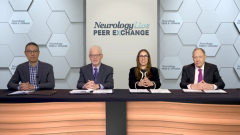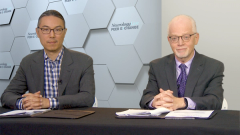
Treatment Selection in NMOSD
Drs Brian Weinshenker, Flavia Nelson, Robert Shin, and Aaron Miller discuss the current neuromyelitis optica spectrum disorder treatment landscape.
Episodes in this series

Brian Weinshenker, MD: Dr Miller,can you tell us a bit about how the treatment landscape has evolved for NMO [neuromyelitis optica], which treatments we were using, and what are we using now?
Aaron Miller, MD, FAAN: For most of my career, we didn’t really have any proven therapies. Anecdotally, over many years, we’ve been treating these with a variety of broad-spectrum immunosuppressive medications, such as azathioprine or mycophenolate. And then with the recognition that this was a disease driven by a specific antibody, we started to use rituximab, a B-cell depleting agent, but it was not FDA approved for the treatment of either NMOSD [neuromyelitis optica spectrum disorder] or MS [multiple sclerosis], for which it is also sometimes used.
But the real revolution came about 2 years ago, and I can remember hearing at the same meeting presentations about several different agents, and I went back to my hotel room and started practicing, can I say eculizumab, inebilizumab, certolizumab, and learning to say those words. And the availability almost simultaneously of the approval of 3 very effective agents has really revolutionized the thinking about how to treat NMOSD.
Brian Weinshenker, MD: And, Dr Nelson, what factors do you take into account when you’re trying to decide which of these treatments to use?
Flavia Nelson, MD: That’s an interesting point. Before that, I just want to add that one of the things we learned between the time that the antibody was discovered and that we had FDA-approved treatments for NMO is that some of the multiple sclerosis treatments could make NMO worse. So that was one of the main reasons to identify whether it was NMO or NMOSD vs MS because we learned that some treatments could make patients worse. We learned the hard way, but nowadays that we have more options, it’s important to, like Dr Miller mentioned, start the treatment right away. And looking at the severity sometimes is helpful in terms of deciding the severity, the number of lesions, and the extent of lesions on the MRI. And, unfortunately, we need to mention the access to care, which sometimes defines the kind of treatment that we use.
Brian Weinshenker, MD: That’s excellent. Bob, I’m going to turn to you and ask you the same question. What factors do you consider in trying to choose a long-term treatment?
Robert Shin, MD, FAAN: Well, as Dr Miller just mentioned, we are lucky to have suddenly the availability of multiple highly effective treatments for NMO spectrum disorder. My first goal, which Dr Nelson mentioned of preventing relapses, one could argue might be achieved by any 1 of those different options. So, in my mind, really, they differ in terms of how they’re administered, and how frequently they might need to be taken possibly from a tolerability standpoint. In my decision-making, I feel lucky to have multiple effective options to choose from. And we spend most of our time talking about in some sense the logistics of how each 1 is given.
Transcript edited for clarity
Newsletter
Keep your finger on the pulse of neurology—subscribe to NeurologyLive for expert interviews, new data, and breakthrough treatment updates.































